#hubert van eyck
Explore tagged Tumblr posts
Text

Hubert van Eyck and Jan van Eyck, Detail from The Ghent Altarpiece
411 notes
·
View notes
Text

Hubert van Eyck and Jan van Eyck (After) - Saint Barbara reading
77 notes
·
View notes
Text

Hubert van Eyck and Jan van Eyck
#jan van eyck#hubert van eyck#art#artwork#fine art#fineart#painting#art history#history of art#women in art#angel#landscape
24 notes
·
View notes
Text

Title: The Ghent Altarpiece (detail) Artist: Hubert and Jan van Eyck Date: ca. 1432 Medium: Oil on wood Size: 375 cm × 260 cm
#oil painting#oil on canvas#oilpainting#flemish art#flemish painter#hubert van eyck#jan van eck#sacred lamb#ghent altarpiece
12 notes
·
View notes
Text

Jan and Hubert van Eyck, The Ghent Altarpiece (detail)
13 notes
·
View notes
Photo

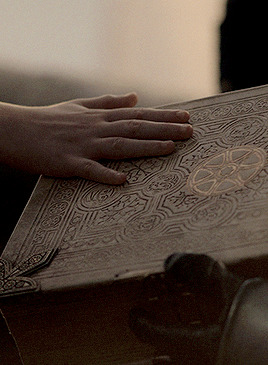

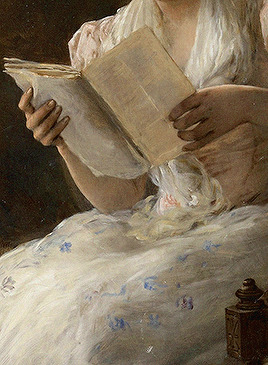


HOUSE OF THE DRAGON + art (4/∞)
Queen Jadwiga's Oath | Józef Simmler Portrait of a Lady | William Oliver The Ghent Altarpiece | Hubert and Jan Van Eyck
#houseofthedragonedit#gameofthronesdaily#house of the dragon#hotd#art#painting#jozef simmler#william oliver#hubert van eyck#jan van eyck#hotdart#hotdedit#*
120 notes
·
View notes
Text

Adoration of the Mystic Lamb (Ghent Altarpiece) by Hubert van Eyck and Jan van Eyck, 1420s-1432.
#classic art#painting#jan van eyck#hubert van eyck#flemish artist#15th century#renaissance#early netherlandish#christian art#ghent altarpiece#lamb of god#adoration#people#angels#fountain#outside
26 notes
·
View notes
Photo

MWW Artwork of the Day (4/9/23) Hubert van Eyck (c. 1385–1426) The Three Marys at the Tomb (c. 1422-26) Oil on wood, 71.5 x 89 cm. Museum Boijmans Van Beuningen, Rotterdam
Hubert van Eyck (also Huybrecht van Eyck) was a Flemish painter and older brother of Jan van Eyck. The division of surviving works between Hubert, early Jan van Eyck, and other painters has been the subject of great debate among art historians, involving the Ghent Altarpiece, the Turin-Milan Hours and other pieces. After a period in the mid 20th century when the tendency was to attribute work away from Hubert, he has made something of a comeback in recent decades, but there is still a wide range of opinion among specialists.
For more of this artist's work see this MWW exhibit/gallery: * The Flemish Masters of the 15th & 16th Centuries https://www.facebook.com/media/set/?set=a.419007544871287&type=3
8 notes
·
View notes
Text

source: @esculturasblancas
The Ghent Polyptych (1432) by Hubert and Jan van Eyck.
Large image here / Imagen grande aquí.
1 note
·
View note
Text
Character profile - Hubert

GENERAL DISCLAIMER: please keep in mind that I got access to these game profiles from gamerch, but unfortunately not all of them have all the information. Wherever you see a "//", it's because that info wasn't on the site and I couldn't find anyone who unlocked it. If you happen to have it, please send it to me! Also, some characters will have more infos than other because they had more cards in the game.
Other note: know that, in this case, "strength" is their painting technique or what they use in paintings.
Name: Hubert (Hubert van Eyck)
CV: Abe Atsushi
Catchphrase: "Self-denying Brother Complex Older Brother"
Hobby: Baking sweets, collecting miscellaneous goods
Likes: Jan, sheep merchandise
Dislikes: Insects
Height: 165 cm
Birthday: February 6th
Favourite food: Curry and rice
Disliked food: Celery
Strength: Detailed and well-balanced picture composition
Special skill: General housekeeping
Relationships with artists: Jan is the most important person for him. He and Millet are housework buddies and Hiroshige is his tea buddy.
How he became an exclusive member: //
What he wants to do: //
Sleeping time: "Let's see, Jan should sleep for 8 hours… Huh, me? I would say about 7 hours for me."
What he wants now: "Sheep merchandise… If possible, I'm interested in a sheep backpack that was recently released."
#palette parade#palette parade tl#palepare#palepare tl#translation#character profile#character profile tl#hubert#hubert van eyck
1 note
·
View note
Photo





Wat? Het Lam Gods (1432) door Hubert en Jan van Eyck met details (middenpaneel, Joost Vijd, Adam en Eva en het Lam vóór en na de restauratie)
Waar? Sint Baafskathedraal, Gent
Wanneer? 20 maart 2023
Wat is een beter manier om een bezoek aan Gent te beginnen dan een bezoek te brengen aan het Lam Gods? Het is zeker niet de eerste keer dat ik dit meesterwerk van Hubert en Jan van Eyck onder ogen krijg, maar het is wel de eerste keer na de grondige restauratie. En ook is het voor het eerst dat mijn bezichtiging van het schilderij wordt voorafgegaan door een augmented reality tour. Een AR-bril zorgt ervoor dat in de crypte van de Sint Baafskathedraal driedimensionale personages opduiken. Ik ben getuige van een processie in een virtuele maquette van de kathedraal, kom terecht in het atelier van Jan van Eyck, maak de beeldenstorm in de kerk mee en ben getuige van de diefstal van twee panelen van het meesterwerk. En dat zijn maar een paar van de ‘haltes’ uit de interessante virtuele rondleiding. Nadat ik mijn AR-bril heb ingeleverd, klim ik uit de crypte omhoog en sta even later in een van de kapellen voor het meesterwerk.
De opdracht tot het maken van het veelluik werd door Joos Vijd en zijn vrouw Elisabeth Borluut gegeven aan Hubert van Eyck. Na diens vroegtijdige dood voltooide zijn broer Jan het werk. Het is niet duidelijk wat precies het aandeel van Hubert is geweest. Dat hij heeft bestaan en dat hij aan Het Lam Gods heeft meegewerkt (twee feiten die lange tijd werden betwijfeld) werd duidelijk nadat in 1823 onder een overschildering op de lijst de volgende Latijnse tekst werd ontdekt: “De schilder Hubert van Eyck, een groter man werd nooit gevonden, vatte dit werk aan. Zijn broer Jan, de tweede in de kunst, voltooide die zware taak op verzoek van Joos Vijd. Die nodigt u, op 6 mei [1432], met dit vers uit om te aanschouwen wat werd verricht.”
In het afgelopen decennium onderging het werk van de gebroeders van Eyck een intensieve restauratie. Daarbij werden alle latere toevoegingen verwijderd en kwam de oorspronkelijke verflaag van de Van Eycks weer tevoorschijn. Dat leverde niet alleen ongehoord felle kleuren op, maar ook bleek de kop van het Lam er heel anders uit te zien dan latere overschilderingen lieten zien. Opmerkelijk is dat het paneel met De rechtvaardige rechters, een kopie uit 1941 die het gestolen en nog steeds vermiste paneel vervangt, in slechtere staat was dan het middeleeuwse werk. Dat laat zien hoe uitstekend Van Eyck het gebruik van olieverf, een toen vrij nieuw medium, beheerste.
Het effect van deze restauratie kan ik alleen maar vergelijken met dat van de restauratie van de Sixtijnse Kapel van Michelangelo. Hierop was veel kritiek. Veel mensen houden graag vast aan wat ze al kennen. Ik vond de gerestaureerde versie echter verbluffend veel mooier dan de ongerestaureerde. En ook de restauratie van dit schilderij kan ik alleen maar toejuichen.
Ik stel me voor hoe het luik met Het Lam Gods voor het eerst ten overstaan van publiek werd geopend. Hoe verbijsterd moeten de middeleeuwers hebben gestaard naar al die kleurenpracht. Een verwondering die wij in onze tijd van kleurentelevisie, 3D-bioscoopfilms en virtual reality nauwelijks nog kunnen invoelen. En toch maakt dit schilderij ook op mij als eenentwintigste-eeuwer nog steeds een verpletterende indruk. Of het nu om bomen en bloemen, gewaden en edelstenen of om de tegels op de vloer gaat: alle details zijn wonderschoon weergegeven.
Al bestonden er in de middeleeuwen geen 3D-films, de suggestie van driedimensionaliteit bestond wel degelijk. En Jan van Eyck wist hoe hij die illusie moest wekken. In het bovenste register van het veelluik staan Adam en Eva in een soort nissen. Dat geeft op zich al een driedimensionale indruk, maar die wordt nog versterkt doordat de voet van Abraham zo is geschilderd, dat het lijkt of hij over de rand van de lijst uitsteekt.
Op het schilderij komen verschillende groepen voor: profeten, maagden, martelaars, christelijke ridders, engelen et cetera. In al die groepen zijn de gezichten individueel en verschillend weergegeven, zelfs op de achterste rijen. Als je De rechtvaardige rechters vergelijkt met de andere panelen, kan het je haast niet ontgaan dat hier een andere schilder aan het werk is geweest. Niets te nadele van Jan van der Veken, maar de gezichten zijn veel minder sprekend dan die van Van Eyck.
Het Lam Gods is een werk van grote schoonheid. Zelfs als je niet gelooft in God en geen enkele relatie hebt met Jezus, ontkom je er haast niet aan de spirituele kracht van dit werk te ervaren. In dat opzicht is het kunstwerk vergelijkbaar met de Matthaüs Passion van Bach. Die spirituele geladenheid werd tijdens mijn bezoek nog versterkt doordat, de hele tijd dat ik aanwezig was, een organist het orgel van de kathedraal bespeelde. Als je met zulke muziek voor Het Lam Gods staat, probeer dan nog maar eens een volbloed atheïst te blijven.
0 notes
Text

Hubert van Eyck and Jan van Eyck, Detail from The Ghent Altarpiece
1 note
·
View note
Text
Hubert van Eyck
The boldest claim for connoisseurship is that it can sometimes resurrect an artist from the version of death that is oblivion or neglect. There is one outstanding example of this, outstanding in both senses, because the artist was no mediocrity but a pioneering genius. His name is Hubert van Eyck, the bachelor brother of Jan van Eyck. Hubert died in 1426, at what age is unknown.
Apportioning work to Hubert and to Jan inevitably begins and ends with consideration of the famous Ghent Altarpiece, The Adoration of the Lamb, which was painted for St Bavo's Cathedral at Ghent and has remained there ever since, bar one stolen panel replaced with a replica.

The Ghent Altarpiece, open (St Bavo’s Cathedral, Ghent, Belgium)

The altarpiece, closed view

The division of labour for the altarpiece’s many panels
Hubert’s story is one of posthumous eclipse: Jan’s work simply covers over and obliterates his brother’s. When eminent scholars have wondered if Hubert’s hand is even discernible in the Altarpiece, his very existence begins to be questioned. Jan’s work, meanwhile, becomes so extensive that one can scarcely believe it possible that so much meticulous, labour-intensive painting could be done in one lifetime by one man. Accepting, as I do, that Hubert did exist and did paint parts of that Altarpiece, I need to say at the outset that I find no particular difficulty in recognising which parts are his and which parts are Jan’s. I believe that Hubert painted all the lower panels of the opened Altarpiece and the four arched panels of it closed. The rest, for me, is Jan’s. Did he take over, and complete, what Hubert had begun?
As we shall see later, another difference between the brothers is that Jan cares about individuals; it is he who paints the portraits of the donors on the Altarpiece and has left us a handful of other painted portraits. Hubert includes many people in his work, but they belong to a repertoire of types, chosen and combined according to need. Survival involves much accident, but i am not sure that he has left us more than one independent portrait.

Hubert’s panels from the opened altarpiece, including the Adoration of the Lamb

Hubert’s panels from the closed altarpiece
There are different elements involved in this distribution and in the distinction drawn by it between two brothers who were both miniaturist in their technique but very different in other ways. Jan’s vision of the world was monumental in the sense that he could create grand figures that occupy a space sculpturally, but the space that they occupy is typically an indoor one This is often quite confined, but even where it is not - say in a church - it is of a kind to make a backdrop to figures which have a looming foreground presence. Such figures serenely dominate the space in a manner that is regal, befitting the Queen of Heaven, Angels, Saints, Sometimes, like real sculptures, they fill niches. By contrast, Hubert’s essential identity as an artist is that of a landscapist The space between him and the horizon is a need of his spirit; he does not want to be confined by walls or to see what delights him only through windows.

The Brothers in side-by-side – Hubert’s talent for creating small forms in big spaces, like the Adoration of the Lamb, stands in contrast to Jan’s preference for setting big forms in small spaces. Both of the above images feature cities in the background, but Jan has set his Annunciation in an enclosed space.

Virgin and Child – ‘The Ince Hall Madonna’ (National Gallery of Victoria, Melbourne)
Jan, then, is a chamber artist, like Vermeer. Take his early Madonna Enthroned, a small picture at Melbourne’s National Gallery of Victoria. The light visits her through the window and illuminates particularly a bit of wall to her right: this passage is pure Vermeer, two hundred years before he, too, immortalised the female presence in an indoor space lit from without. Already in the illuminations of the Turin Hours which I follow Kenneth Clark in giving mainly to Hubert - he is evincing a totally different take on the world, one that revels in a storm at sea, a calm lakeside, or the long line of a coast. He can make us feel the cold salt air and see the waves rolling in onto a low shore where a Duke and his entourage have landed and ride up the dunes on their way to his castle. Faced with painting figures in a room or a church, however, and one immediately senses that Hubert, at that stage, is less at ease, his discomposure evident in a relative lack of both atmosphere and compositional unity.

Miniature illustrations from the Turin Hours. Clockwise from top left: Agony in the Garden; The Cavalcade (destroyed); Baptism; Office of the Dead; Miracle of Sts Julian and Martha. All surviving works Palazzo Madama, Turin
LANDSCAPE
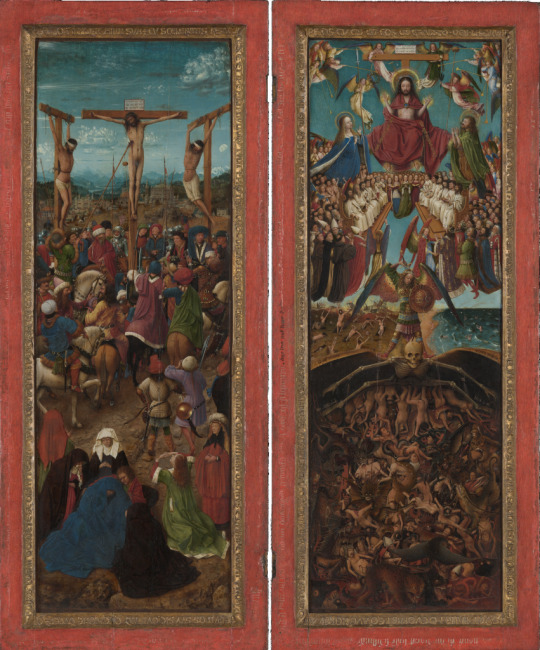
The Crucifixion and The Last Judgement (Metropolitan Museum of Art, New York)
Further evidence of Hubert’s interest in landscape can be seen at the Metropolitan Museum in New York; here we find the Channel coast again, the rollers coming in onto long stretches of what are now Belgian beaches. The sea is a Prussian blue - a shade that Hubert particularly loves - with drowning souls in it pleading to be saved, like their luckier compatriots on land, from the horrors of Hell beneath. In the left-hand panel is an early version of a typical Hubert landscape: middle distance warmth of foothills and human habitation receding to a far range of blue mountains fading into blue sky, and all in clearest visibility (atmospheric sfumato still unborn). Both panels are crowded with people dead and alive, but the landscapes complement the crowdedness with an airiness and spatial largesse that is all-inclusive and ruffled only by some fretted cumulus and fretted waves. There are many colours, but they answer each other across the panels as might happen in a pair of stained-glass lancets. The correlations are not only chromatic but formal: the rising foothills of the left panel continue into the white lining of the Virgin’s blue robe in the right panel, and the darkness behind the arms of Death spread over into the left panel.
It is Hubert’s gift to give to crowded, jostling humanity so much space around it and so much air above it. As in the lake and coastal scenes of the Turin Hours there is conveyed to us the breathed atmosphere of a huge encompassing space that is beyond, yet all around, whatever is happening in the human world. He is very sensitive to this essentially calming influence of the natural world that is also, for him, a sacred one.
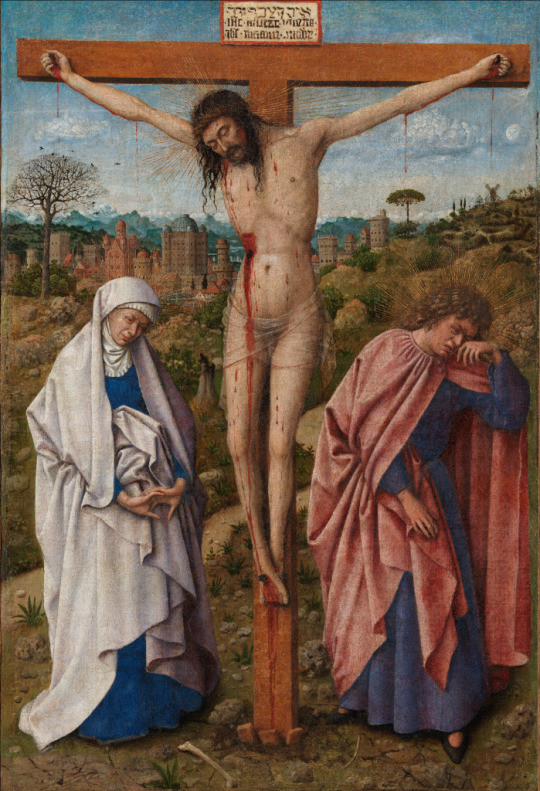
Christ on the Cross with the Virgin and Saint John ( Gemäldegalerie, Berlin)
In Berlin’s Gemäldegalerie there is a small Crucifixion with just Mary and John either side of Christ, she downcast and resigned, clasped hands out-turned, John turned away, weeping. The lovely landscape behind seems wintry, echoing the elegiac mood with a tall bare-branched tree; a city lies low amid uneven, intractable terrain, with a backdrop of remote mountains. Close up to the picture plane, the human scene is emotionally near, the viewer forming a fourth witness to a Passion whose outpouring is visible blood, invisible tears. The suffering, with that much haemorrhage, must be over, and the end is a resignation that makes a kind of peace with the larger world, shorn and naked now, but assured of resurrection. The picture illustrates perfectly Hubert’s ability to match landscape with human drama and emotion.
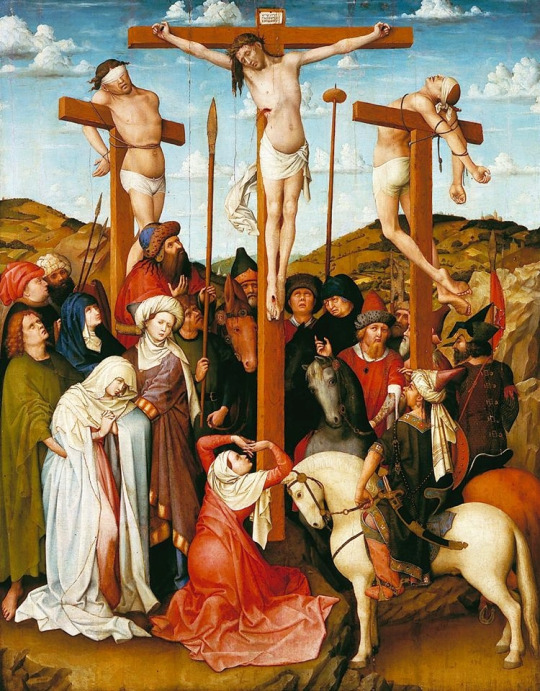
Crucifixion, National Museum of Poznan, Poland
In another Crucifixion, at National Museum in Poznan, Poland, crowded onlookers react in their different ways to the anguish on the Crosses. Again the landscape is important; no mountains, but a backdrop of partly wooded hills below a sky of scudding cumulus moving along with an event that is still unfolding, a Passion not yet spent.
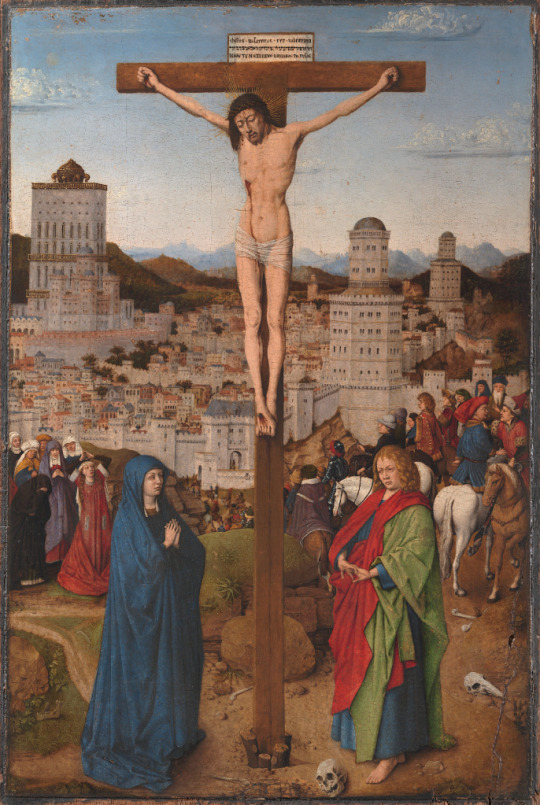
Crucifixion, Ca d’Oro, Venice (attrib Hubert v Eyck or school of J v Eyck)
A late Crucifixion at the Ca d’ora in Venice shows the same out-turned hands we saw in Berlin, this time on John. This Crucifixion represents a substantial departure from earlier ones. Christ seems lifted high above Mary and John, while the city has come alarmingly close, a threatening source of crowds who are standing around, a little down from the hill of Golgotha. A group of women on the left look up at the back of Christ, while men on the right, on horseback, look in other directions as if the show they came to see is finally over. As for the city, it encourages Hubert to flights of architectural fantasy. Three structures of Babel-like height and mass tower over the huddled houses, more out of scale than even the real-life cathedrals were in Hubert’s day or the skyscrapers in ours. Either side of lonely Pathos, Hubris is rising ever higher.The division of women to the left of the Cross, men to the right of it, signals a contrast, almost a contest, between compassion and indifference; but the triangle made by the feet of Christ and the hands of Mary and John - reversing that made by the arms of Christ and the crossbar of the Rood - marks the personal, almost private and familial nature of the event at this late stage when onlookers begin to look elsewhere.

St Francis Receiving the Stigmata, Philadelphia Museum of Art
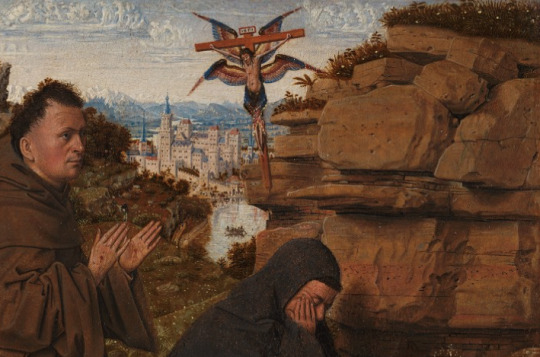
Detail of rocks
In the Johnson Collection at Philadelphia's Museum of Art we are with Saint Francis kneeling among rocks before his vision of the crucified Christ. The theme of wakefulness and sleeping that was there in the Gethsemane of the Turin Hours has returned with a difference. Here colour is used to suggest, not the contrast between people and their surroundings, but a Franciscan harmony between them. The Saint is clothed in the brown habit of the wilderness in which he prays, while his Brother, linked to him by the cords of their shared vows, is lost in sleep or meditation. What unites this image with the far cooler and more distanced Gethsemane is the treatment of rocks, well in advance of Leonardo’s studies, but no less beautifully observed.

Left: St Christopher Carrying the Infant Christ, Phildelphia Museum of Art; Right: Copy of a lost drawing attributed to J v Eyck of the same scene, Louvre Museum, Paris
Rocks bring us back to Philadelphia, to an exquisite small Saint Christopher carrying the Christchild through shallow water between towering cliffs sprouting trees and bushes. Behind the Child is a lake with distant mountains. Most notable here is the painting of the foreground water - a painterly achievement not attempted in the associated drawing at the Louvre. Such an understanding of water, its surface and depth, the way it moves under pressure of wind and current, is astonishing at so early a date, though we already saw it at Turin, in the Storm on Galilee. There seems to be nothing in the natural world of which Hubert has not made himself master, always on a small scale and with that miniaturist technique that he shared with his brother. We see a mediaeval inheritance being used to quite new ends, and taken to the height of realistic fidelity in a medium that we have to remind ourselves was still in its infancy, What he does is breathtaking in its virtuosity, but also very affecting in its sensitivity and delicacy of touch. he applies his brush as finely as the bow of the most accomplished string player.
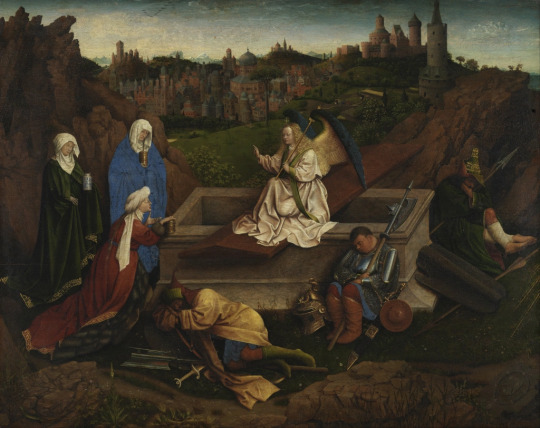
Three Maries at the Tomb, Boijmans Museum, Rotterdam
In connection with landscape the last work I want to consider before the Ghent Altarpiece is his painting at Rotterdam's Boijmans Museum, the Three Maries at the Sepulchre.Here, more than ever, we see him using landscape and sky to reinforce a human story. It is not so much a nocturne as an aubade, an evocation of night becoming dawn, well before the sun is up; the sky begins to lighten but night still pervades. The soldiers are asleep, the women are awake; the Angel. like Aurora, female, winged. It is a ghostly hour. The weapons of day, the active life of men, are laid aside as diagonals around the rectangle of the Sepulchre. Beyond that is the still-slumbering city, its towers pushing up into the sky like pinnacles of rock, the bedrock on which the whole scene rests. Like the magician that he is, Hubert can cast a spell of nocturnal obliviousness over what in daylight would be local colours, leaving only certain reserved accents of white in the middle band of the composition - the women’s headdresses, Angel’s robe, a man’s socks - to denote the wakefulness heralded by the whitening sky and a Resurrection on Earth within the Resurrection of Light.
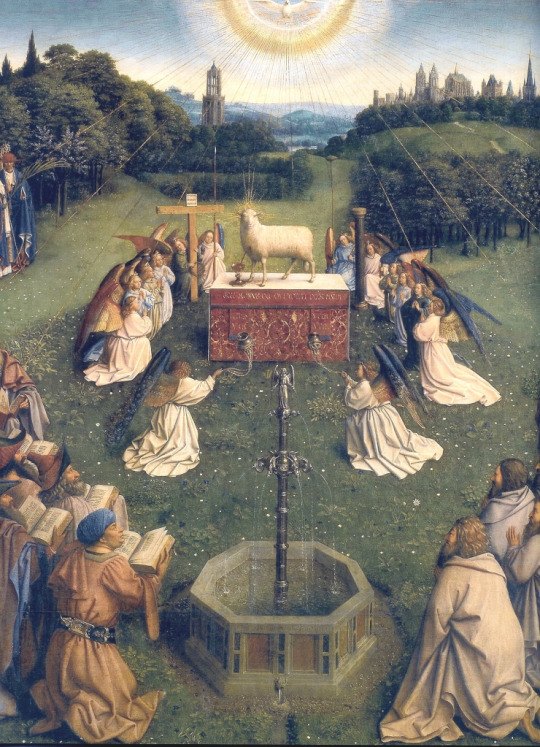
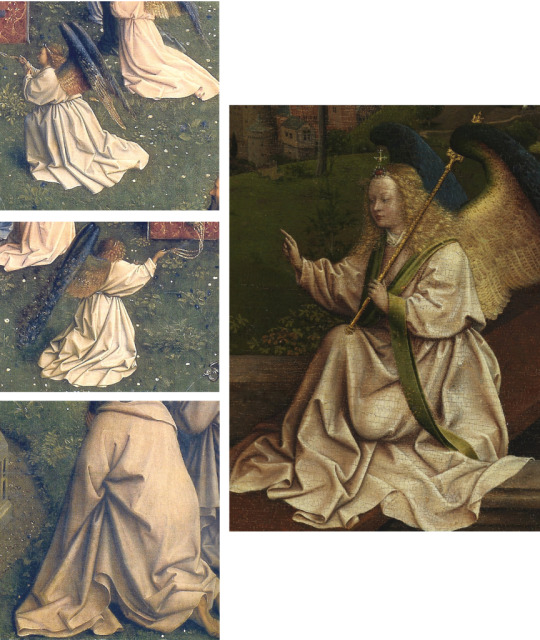
Drapery details from Ghent’s altar of the lamb can be compared with those of the angel’s robes in the Three Maries
We have arrived now at that heavenly vision that is Hubert’s contribution to the Ghent Altarpiece.The daisies around the feet of Saint Francis, at Philadelphia, return in the grassy bank around the Altar of the Lamb, and there too the drapery of those angels falls in folds like those of the Angel on the Sepulchre at Rotterdam. As in the panels in New York, we find groups crowded together but here transformed into outdoor choirs in a landscape that holds them generously; there is ample space between them in which our eye can move around freely, like a bee, alighting on ever more extraordinary detail. The landscape is idealised, yet recognisably a northern one, of rolling hills and woods between prosperous, aspiring towns, all transformed into a Paradise Garden where every leaf and petal counts and towns become Jerusalems, Cities on the Hill.
On Hubert’s landscape sensibility I have surely said enough to convey how exceptional I think it was and to highlight especially (since landscape was not yet an independent genre) his ability to make it echo sympathetically the pathos of a Crucifixion or other human enactment. His brother also had very considerable gifts when landscape was required, but this particular marriage of mood is not evident in his work; his forte is indoors. If Jan could not have painted The Women at the Sepulchre, Hubert could not have painted the Arnolfini picture. If Hubert’s favourite subject was the Crucifixion in a landscape, Jan’s was the Enthroned Madonna in a room, The contrast between their powers is what my division of labour in the Ghent Altarpiece makes eloquent, There exist some polyptychs, later and elsewhere, that are a mixture of two-dimensional painting and three-dimensional sculpture. The Ghent Altarpiece is all painting, but something of that difference is there: Jan’s large figures possess the physicality of sculpture in the round, while Hubert shows himself as more purely a painter. Nothing in Hubert’s contribution reminds one of that; it consummates his love of space and landscape, while the figures, of which there are many, exhibit a variety of facial types significantly different from Jan’s.It is to these that I now turn.
LANDSCAPE WITH FIGURES
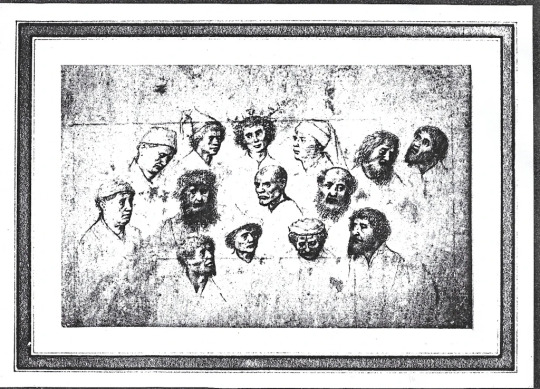
A series of studies of fourteen heads of men, some thought to be for ‘The Adoration of the Shepherds’, variously attributed to J v Eyck and Gerard David
It is fortunate that in the Berlin Print Room there is a sheet of drawn heads that provides exactly what we need. Given the similarities which I shall illustrate, there is no doubt in my mind that this sheet is by Hubert and not by Gerard David or any later artist.
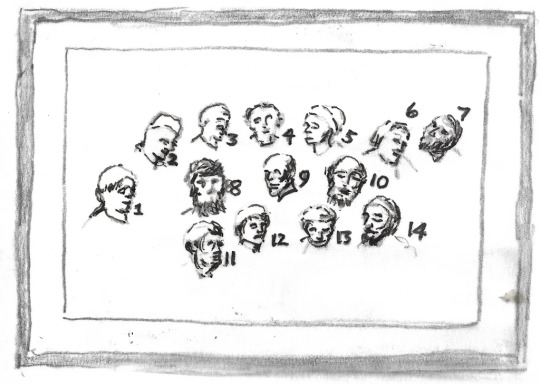
It is helpful to number these heads, so that we can refer to them individually in relation to paintings. Head number 4, for example, reappears as the central figure in a panel at the Boijmans Museum at Rotterdam depicting Saint Catherine led away to her Martyrdom.
in one of a pair of panels at Rotterdam attributed to the ‘Southern Netherlands School’ but much more convincingly to Hubert, albeit in a relatively early phase of his career as a painter of individual panels. This is one of a pair, the companion being Saint Catherine preaching to the Emperor, at the Philadelphia Museum of Art. Already in these panels we encounter certain Hubertian traits, elaborate metallic tiaras and complicated headgear, the beginning of that fascination with flowered lawn, the springing leaves of grass touched in with the fine tip of the brush, and also hand gestures, witness the left hand of the Saint in the other panel at Rotterdam and the right hand of the Virgin Annunciate in Washington.
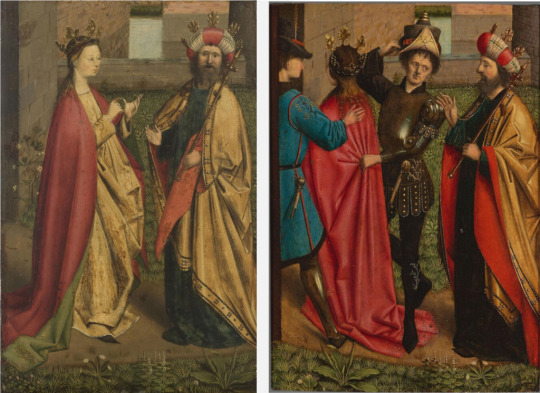
Left: St Catherine Preaching to the Emperor, Philadelphia Museum of Art, and its apparent pair, Right: St Catherine Carried Away to be Beheaded, Boijmans Museum, Rotterdam

Comparing the hands of the Virgin the Annunciation at Washington with the hands of the Emperor
Heads numbers 10 and 14 are basically the same head at different angles, and he is a character who appears, wearing dark prussian blue, above the sea in the righthand panel at New York, in the head of Saint John (in green), and several times on the opposite side of the same panel, above the bishops. Number 7, the central head of the drawing, appears on the left panel, on the extreme right, below the left leg of the righthand thief on his cross.
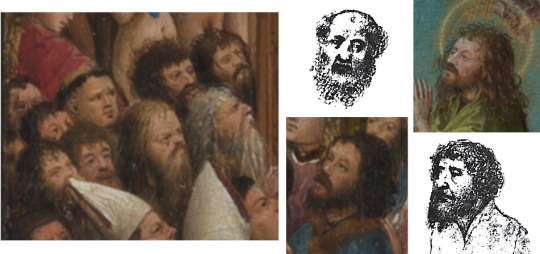
The heads from the earlier chalk study appear in the Crucifixion and Last Judgement panels
These correspondences suggest to me that the Berlin drawing may be contemporary with the New York panels, but the types, which are not Jan’s, recur in different contexts later, which is why I regard the drawing as a helpful index to Hubert’s characterisation.It only represents a few types (or ‘tronies’); the full repertoire, as demonstrated at Ghent, is more extensive. Number 9, to mention another that is very common in Hubert’s work, is well represented at the Albertina in Vienna by the drawing of Saint Andrew holding his Cross.

More heads can be found in St Catherine Carried Away, the Last Judgement and in a drawing depicting St Andrew
All this is not to say that Hubert only did landscapes and Jan only interiors, as we can see in these two examples: the first is Hubert’s tall Annunciation in the Mellon Collection at the National Gallery of Washington and on Jan’s side the Louvre Madonna with Chancellor Rolin.
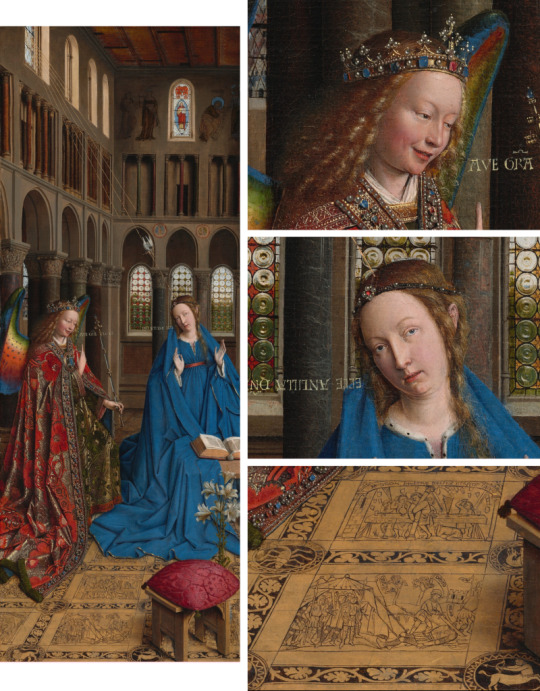
The Annunciation, attrib Jan van Eyck, National Gallery of Art, Washington
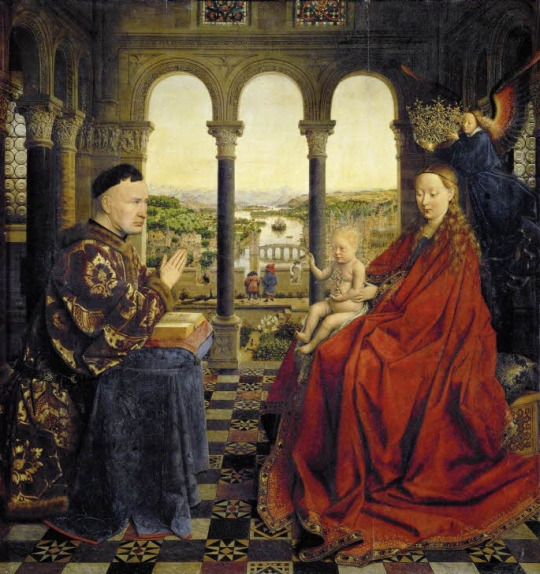
Madonna of Chancellor Rollin, Jan van Eyck, Louvre
Neither Hubert’s smiling Angel nor his Virgin is as Jan would have painted them. The general brownness of the cathedral’s architecture and pavement (reminiscent of the ‘pensive’ brown of the Saint Francis) beautifully conveys the dim stillness of the lofty church, the privacy of reflection, and how revelation, in that ambience, is a matter of inward illumination. The Virgin does not face the Angel nor us, she tilts her head and looks to our right, her gaze on the axis of the dove’s silent swoop. The illumination is in the robe and wings of the Angel, the same colours that are in the stained glass of the window above the Virgin’s head. As in the landscapes, the dim, airy interior of the church matches exactly the mood and moment of the scene enacted; natural and supernatural , visible and invisible, fuse into one.

Facial features in Veronica’s Veil at the Phildelphia Museum of Art can be compared with those of the Virgin from the Annunciation at the National Gallery in Washington
Before leaving this Annunciation it is pertinent to mention a Head of Christ, presented as a Veronica Veil, in the Johnson Collection at Philadelphia, which I give to Hubert. I leave the eyes of the reader to match its features with those of the Virgin.
Drapery is something connoisseurs have to get to know in all its rhythmic convolutions, and nowhere more so than in Netherlandish art where the representation of it reaches astonishing levels of virtuosity in some artists and is always subtly different through whatever hand it is expressed. The ridges and valleys of falling and spreading drapery begin to constitute a landscape in themselves. It is important, therefore to consider Hubert’s own treatment of it which is not greatly different from his brother’s, but subtly so.

Left: Lost illustration of the Virgin and Child from the Turin Hours; Right: The Mystic Marriage of St Catherine, Germanisches National Museum, Nuremberg
Back at Turin, one of the illuminations in the Hours is this one of the Virgin with her Child surrounded by female Saints. The drapery, spreading like foam on a beach onto the flowery meadow, is archetypical of Hubert: very fluent and supple with quite wide spaces between the ridges. We can see this more confidently expressed in a splendid drawing from Nuremberg, of the Mystic Marriage of Saint Catherine.The sparse folds and rhythms are more pronounced because much later, perhaps even contemporary with his work on the Ghent Altarpiece; the types, female and male, that flank the central group in the drawing are recognisable in the various groups of its painted figures. In the Ince Hall Madonna at Melbourne Jan comes closest to Hubert in the fall of folds that swirl about her, but his drapery later on becomes much more like the painted equivalent of lime wood carving as in the large figures at Ghent.This reflects the difference already noted: Jan tending increasingly towards sculptural monumentality, Hubert remaining more essentially a painter.

Left: Madonna at the Fountain, Hubert van Eyck; Right: Madonna at the Fountain, Jan van Eyck, Koninklijk Museum voor Schone Kunsten, Antwerp
I have made the point that Hubert was more interested in landscape, Jan in the indoor world. This is nicely illustrated by each of them painting a version of the same subject, the Virgin and Child standing by a Fountain. Hubert places Mother and Child wholly outdoors, grass and flowers at her feet and a bosky background of trees and shrubbery behind a low brick wall. Jan has the Virgin stood on a rich backdrop of brocade that is held up by angels. Yes, there is a rose hedge, low wall, flower-spangled lawn, but it is noticeable how the gold foliage on the brocade is assimilated to the real foliage and real flowers behind and below. Similarly at the top there is assimilation of the angels’ red and gold to the red and gold of the brocade whose edging continues into the edging of their wings. In other words an indoor prop, the brocade, signals that the Virgin and her Child are only half outdoors.

The Annunciation, Metropolitan Museum of Art, New York
A picture that may well belong to the period of the Hubert Madonna at the Fountain is the Annunciation at the Metropolitan Museum in New York, with Mary standing at the doorstep of a lofty portal. Notice the similar treatment in both cases of trees, wall, plants and lawn, as well as the heavy-looking drapery folds in the figure of Mary.
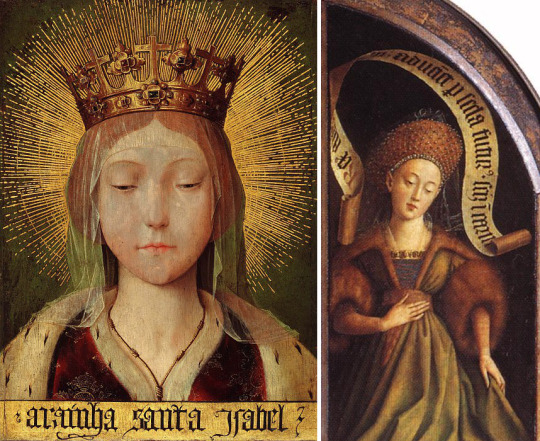
Left: Queen Isabel (St Elizabeth) of Portugal (attrib Massys et al), Gemäldegalerie, Berlin; Right: Cumaen Sibyl from the Ghent Altar
At the beginning of this Study I proposed a very simple division of Hubert’s and Jan’s contributions to the Ghent Altarpiece: all the lower tier of the opened polyptych is Hubert’s, plus, when it is closed, the four arched panels at the top. The latter are interesting because at the Gemäldegalerie in Berlin there is a little-known, little-discussed panel of the Holy Elizabeth of Portugal, attributed at times to Quentin Massys and also, vaguely, to a Portuguese-Spanish master, and dated around 1500. To my eye it belongs in an earlier period and its rightful home is in the work of Hubert van Eyck. The head should be compared with that of the Cumaean Sibyl, the lettering with that of her scroll (or any of the scrolls), the tiara with that on the Angel of the Annunciation, the radiance of the aureole with Hubert’s radiances throughout his career.
Portraiture features prominently in the work of Jan van Eyck. We have five separate portraits as well as those of Arnolfini in the London Marriage picture and Chancellor Rolin in the painting of him and the Virgin at the Louvre. It is not apparent from extant work that the same is true of Hubert. The Berlin drawing of heads is a drawing of types, some the same seen from two angles, and as such it represents part of a repertoire of visualised characters who can be introduced into crowd scenes. I may be wrong, but I doubt if many of the heads in the Ghent Altarpiece are portraits. There is, however, one independent portrait that seems different from the Jan portraits and that is the Man in the Blue Cap at the Brukenthal National Museum in Romania. The closest comparison is probably with the heads of the nearest banner-holders on horseback in the Ghent Altarpiece. The vivid Prussian blue is a staple of Hubert’s palette at least as far back as the panels in New York.

Left: Detail of riders from the Ghent panel; Right: Man in a Blue Cap (attrib J v Eyck), Brukenthal National Museum, Sibiu, Romania
Naturally, much more could be said (and by others has been) about that complex masterpiece. My concern has been to mark the difference in style and scale between the contributions of the two brothers. They worked in the miniaturist tradition, but they applied their miniaturism - their technical ability to represent very fine detail- in quite different areas. The paradox in Jan’s work is that he actually thought big, not small, in the sense that he conceived large, monumental figures first, and then bestowed on them a wealth of pin-sharp, jewel-like detail. He liked them to fill and dominate the space he gives them, even to the point of making them seem too small for it, as in the Angel and the Virgin in the Ghent Annunciation, both of them large presences in a low-ceilinged room.
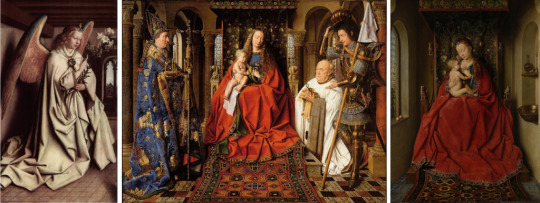
Left: Detail from the Ghent Annunciation; Centre: The Virgin of Canon van der Paele, Groeningemuseum, Bruges; Lucca Madonna, Frankfurt
Hubert is the converse of Jan: his figurative scale is smaller, as befits a landscapist, but his spatial scale is vast, as we have seen. Along with the Limbourg brothers and Jean Fouquet, Hubert stands at the beginning of the long story of European landscape art. Part of what distinguishes Hubert in this tradition is what I would call his sympathetic landscape, one that reinforces the human story. When landscape eventually, but gradually, becomes an independent genre, this accord gets lost; not entirely because Poussin is a master of it. In a Claude landscape Aeneas seems an introduced character, adding an extra mythological element to an idealised pastoral; the same is true of Hannibal or Polyphemus in a Turner. In Hubert’s day Man and Nature could be seen together in a vision that sacralises both. That vision involved huge distances, great depth of aerial perspective. After the flatness and abstraction of the twentieth century we have difficulty, pictorially, giving expression to such spatial awareness; a nostalgia can creep into our appreciation of Hubert’s art. We must find new ways.
In view of Hubert’s prodigious talent it is fairly shocking that his art has been so eclipsed by Jan's, so comprehensively overlooked. There should be as many monographs and picture books, articles and exhibitions about him as there are about Jan, but there are not. Ask any person of average visual culture about Jan and the name and some works - probably the Arnolfini picture - will be familiar. Ask about Hubert and the response is a mystified, interrogative ‘Hubert?’ The essential purpose of this Study has been to remove that question mark. Like the remarkable Master of the Pieta de Villeneuve (at the Louvre) Hubert is a great artist whose fate has been to have his work confused with that of another great artist, in the Master’s case with Enguerrand Quarton, in Hubert’s case with his brother. It is in this sense that I claimed for connoisseurship the power, sometimes, to resurrect. The resurrection, however, is not instant or miraculous but a patient, collective process that, once begun, must continue.
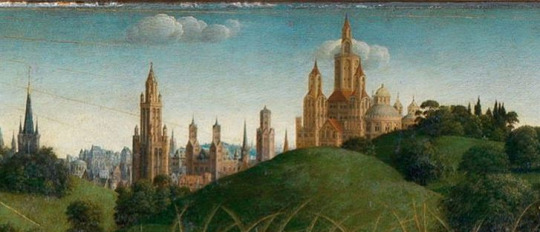
Cityscape from the Ghent Altarpiece
Just to scroll back through the coloured illustrations of this Study is to be reminded of medieval illuminations, their bright, unfaded, undarkened colours, and of course their miniaturism. Yet in other ways Hubert looks forward, not backward, moving clear-sightedly out of the Middle Ages into the humanism of the Renaissance and on towards all that followed in our European landscape art. We owe him, I think, a huge debt.
On the subject of debt, I wish to acknowledge here what I owe to Emily Wetherell who has helped me so much, and so tactfully, with this Study and many of its predecessors. Not only has she been the technical assistant to a technophobe, she has done a great deal of picture research, checking the locations and current attributions of pictures and drawings, as well as making numerous suggestions about how to improve the text. Crucial to the visual argument of all these Studies, however, is the juxtaposition of images, and she has contributed materially to making clearer those comparisons and connections that are at the heart of any serious connoisseurship.
#studies in connoisseurship#hubertvaneyck#vaneyck#jan van eck#hubert van eyck#art history#connoisseurship#miniatures#turin hours#illumination
1 note
·
View note
Text
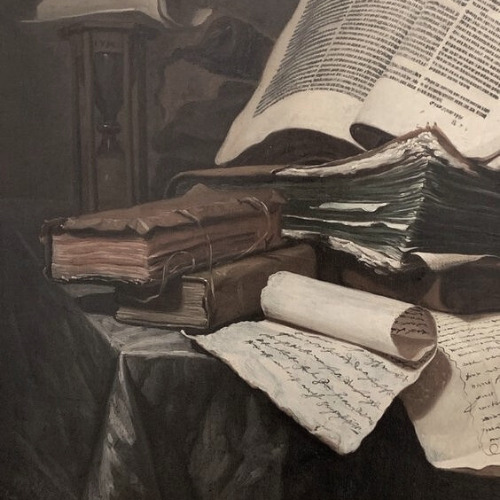






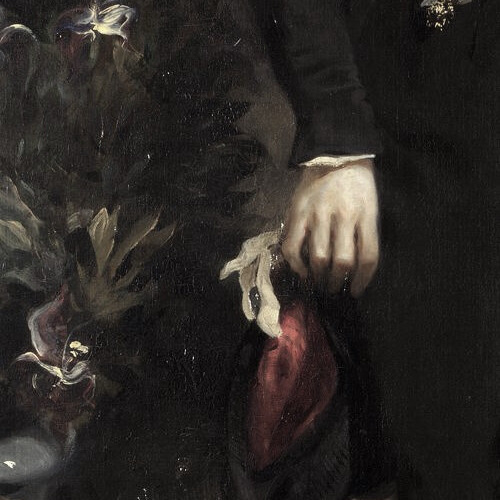
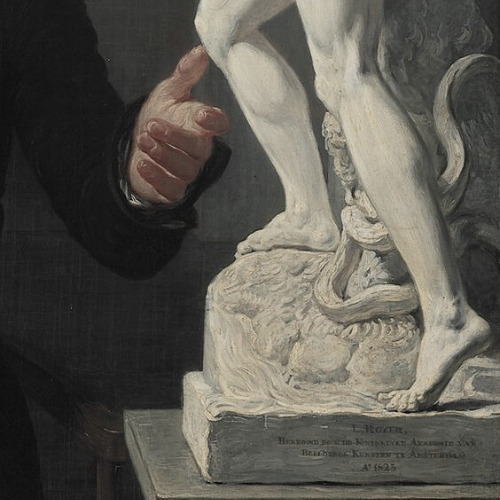
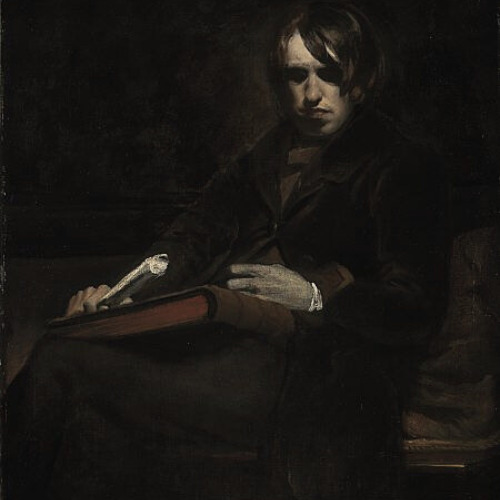

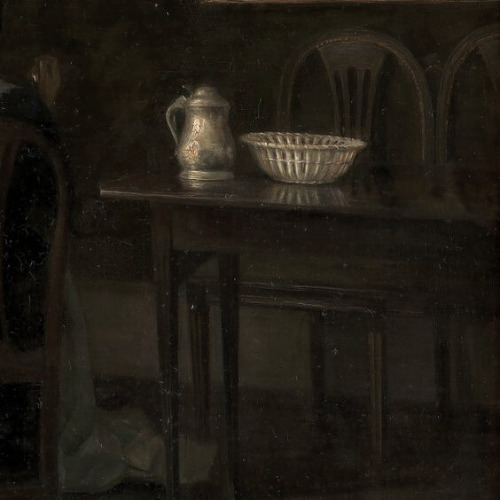
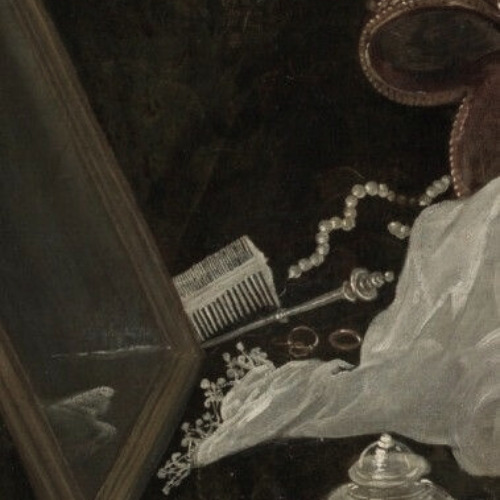



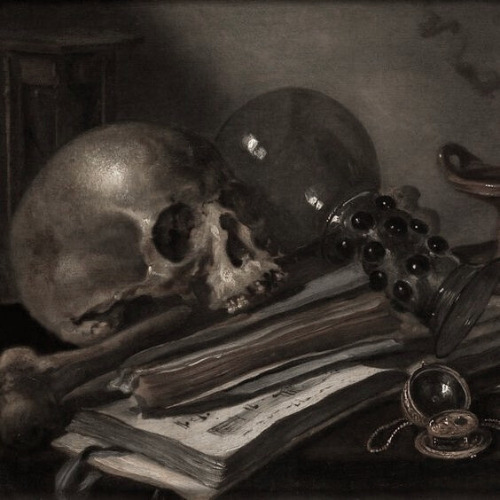
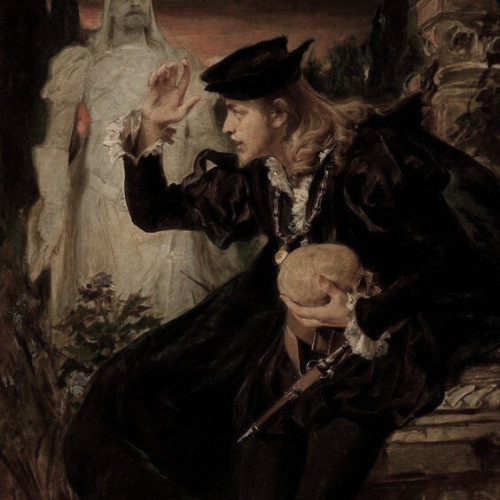
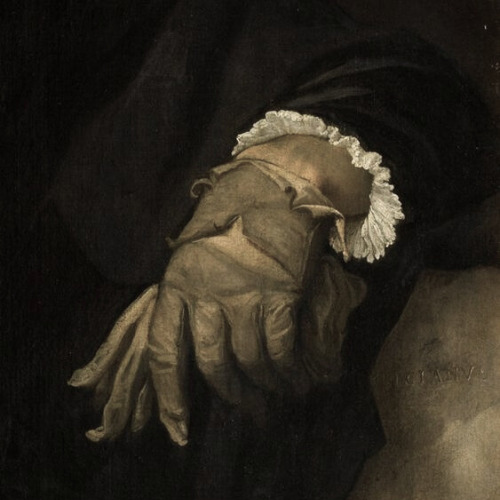

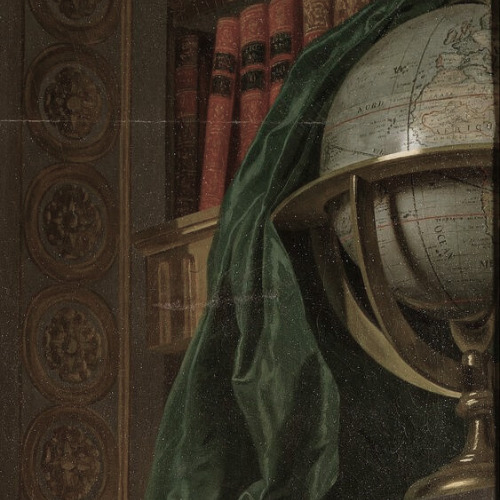



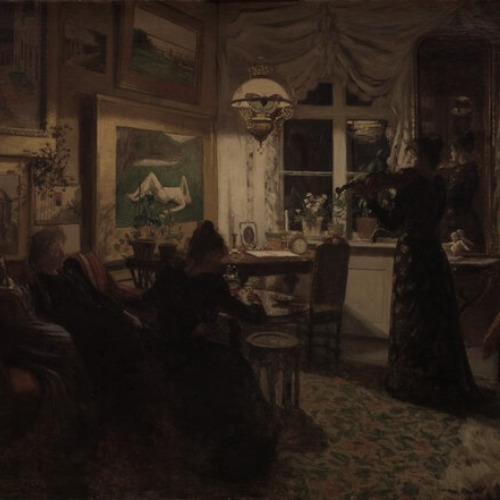
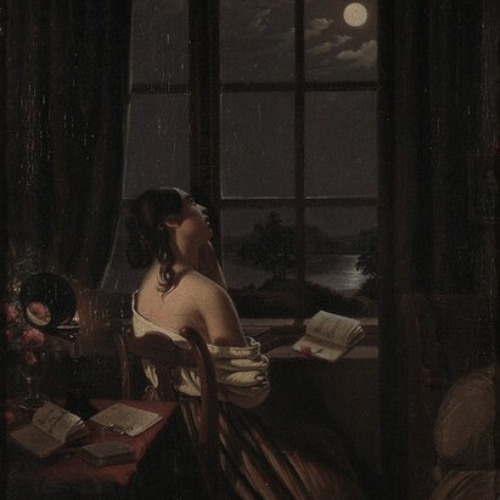


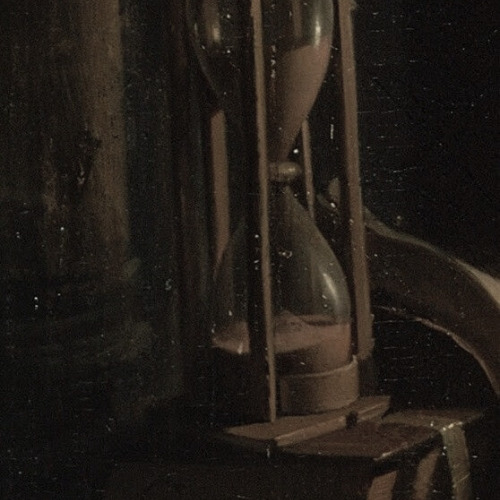

art aesthetics: dark acadmia
#cant find artist#artist is gerrit dou#artist is paul fischer#artist is james carroll beckwith#artist is sir anthony van dyck#artist is nicolas regnier#artist is hubert and jan van eyck#artist is eugene delacroix#artist is jan willem pieneman#artist is sir william fettes douglas#artist is wilhelm bendz#artist is carl holsoe#artist is jacopo tintoretto#artist is thomas wyck#artist is lindsay bernard hall#artist is franz ludwig catel#artist is pieter claesz#artist is pedro americo#artist is titian#artist is giorgio vasari#artist is alexander roslin#artist is jusepe de ribera#artist is anne francoise couloumy#-artist is carl holsoe#artist is anna petersen#artist is peter hasenclever#artist is irving ramsey wiles#artist is georges de la tour#artist is unknown-#art aesthetics
501 notes
·
View notes
Text
Seeing the Great Art Hitler Stole
Carole and I spent a week in Belgium where we saw two masterpieces stolen by the Nazis and retrieved by the Monuments Men. The works were worth saving and seeing.
Seeing art masterworks in person is always a pleasure. Seeing masterworks stolen by the Nazis and recovered by the Monuments Men makes viewing them even more pleasurable. Michelangelo’s Madonna and Child, his first sculpture to leave Italy in his lifetime, can be seen in an ancient Bruges church. The Adoration of the Mystic Lamb, a polyptych painted by the Van Eyck brothers, is on display in St.…

View On WordPress
#George Clooney#George Stout#Harry Truman#Hitler art theft#Hubert and Jan van Eyck#Michelangelo&039;s Madonna and Child#Rose Valland#The Monuments Men#The Mystic Lamb
0 notes
Text


The Lamb of God (1432)
— by Hubert and Jan van Eyck
#art#artist#artblr#historical art#art history#religion#religious imagery#artists#painting#art community#fine art#art gallery#christianity#christian faith#christian blog#christian living#lambs#lamb#vintage#art blog
2K notes
·
View notes